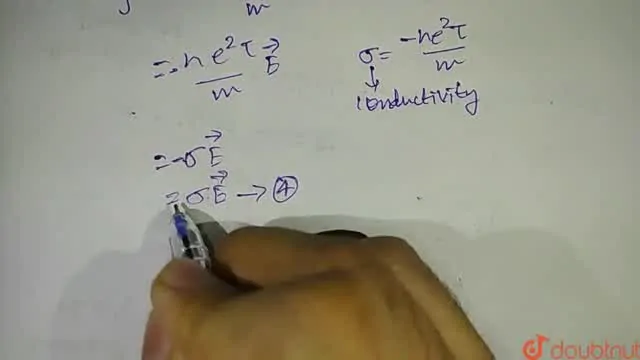Describe the microscopic model of current and obtain general from of Ohm's law. Solution in Tamil
Video Solution
Text Solution
(i) Consider a conductor with area of cross section A and an electric field →E applied from right to left. Suppose there are n electrons per unit volumne in the conductor and assume that all the elecrons move with the same drift velocity vd as shown in Figure. ,

(ii) The drift velocity of the electrons =vd
The electrons move through a distance dx within a small interval of dt
vd=dxdt,dx=vddt ...(1)
(iii) Since A is the area of cross section of the conductor, the electrons available in the volume with time dt is
= voltmeter × number per unit volume
Adx×n ...(2)
Substituting for dx from equation (1) in (2)
=(Advdt)n
Total charge in volume element dQ=
(charge) × (number of elctrons in the volumne element).
dQ=(e)(Avddt)n
Hence the current I=dQdt=neAvddtdt
I=≠Avd ....(3)
(iv) Current density (J) the current density (J) is defined as the current per unit area of cross section of the conductor.
J=IA
The S.I unit of curent dencity is Am2(i.e.)
J=neAvdA (From equation 3)
J='≠vd .....(4)
(v) The above expression hold only when the direction of the current is perpendicular to the area A. In general the current density is a vector quantity and it is given by
→J=nevd
Substituting →vd from equation →vd=eτm→E
→J=n.e2τm→E ...(5)
→J=σ→E ....(6)
Where σ=−ne2τm is called conductivity. the equation (5) is called micrsocopic form of ohm's law.
|
Updated on:21/07/2023
Similar Questions
Electric Current | Current Density | OHM'S Law
56:27View SolutionWhat is current density ? Derive Ohm's law in form of current density?
04:33View SolutionAssertion: Ohm's law is not valid if current depends on voltage non-linearly.
Reason: Ohm's law is a fundamental law of nature.01:47View SolutionBasics of Electric Current and Ohm's Law
36:56View SolutionMicroscopic Analysis OF Current Drift Velocity||Resistivity||Ohm's Law in Vector Form
54:14View SolutionWhat is Ohm's law? Describe.
02:37View SolutionAverage and instantaneous current | Drift velocity | Mobility| Current density | Ohm's experimental law | Ohm's Law from drift velocity | Temperature dependence of resistivity for conductors | semi comductors and super conductors | Temperature dependence of resistance
50:24View SolutionTutorial based on Current | ohm's law and resistance
59:53View Solution


